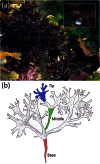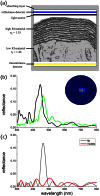Structural colour in Chondrus crispus
- PMID: 26139470
- PMCID: PMC5155586
- DOI: 10.1038/srep11645
Structural colour in Chondrus crispus
Abstract
The marine world is incredibly rich in brilliant and intense colours. Photonic structures are found in many different species and provide extremely complex optical responses that cannot be achieved solely by pigments. In this study we examine the cuticular structure of the red alga Chondrus crispus (Irish Moss) using anatomical and optical approaches. We experimentally measure the optical response of the multilayer structure in the cuticle. Using finite-difference time-domain modelling, we demonstrate conclusively for the first time that the dimensions and organisation of lamellae are responsible for the blue structural colouration on the surface of the fronds. Comparison of material along the apical-basal axis of the frond demonstrates that structural colour is confined to the tips of the thalli and show definitively that a lack of structural colour elsewhere corresponds with a reduction in the number of lamellae and the regularity of their ordering. Moreover, by studying the optical response for different hydration conditions, we demonstrate that the cuticular structure is highly porous and that the presence of water plays a critical role in its ability to act as a structural light reflector.
Conflict of interest statement
The authors declare no competing financial interests.
Figures





References
-
- Chapman R. F. Visual signals: color and light production in The insects: structure and function (eds Vukusic P. & Chittka L.) 793–823 (Cambridge University Press, 1998).
-
- Parker A. R. 515 million years of structural colour. J. Opt. A: Pure Appl. Opt. 2, R15–R28, http://iopscience.iop.org/1464-4258/2/6/201 (2000).
Publication types
MeSH terms
Grants and funding
LinkOut - more resources
Full Text Sources
Other Literature Sources

